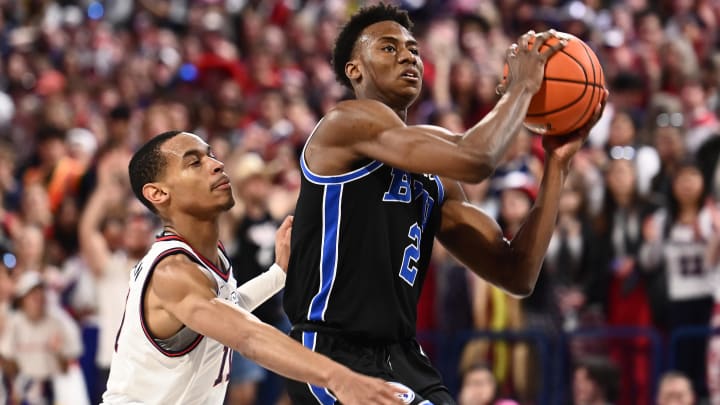Is more conference realignment coming? 'It’s going to look very much like an NFL minor league'

This time a year ago, Gonzaga was in discussions about potentially joining the Big 12 Conference, which had just added four former Pac-12 schools to its roster for the 2024-25 season and beyond.
In a quest to create the best college basketball league in the country, Big 12 commissioner Brett Yormark brought in Arizona, Arizona State, Colorado and Utah to form a 16-team league that also had just added BYU, UCF, Cincinnati and Houston a year earlier. Yormark wanted the Zags and had serious talks with the school last fall prior to the start of the 2023-24 season. Since then, however, nothing has materialized amid concerns from Big 12 leaders over sharing their revenue with a non-football school.
While it appears the dust has settled on conference realignment for now, Utah football coach Kyle Whittingham believes another seismic shift in college athletics is on the horizon.
“I think there is a major realignment coming and it’ll be a big one. I think it will create even more of a divide and exclusivity for the teams that are on the right side of that line,” Whittingham told John Canzano. “In my opinion, it’s going to look very much like an NFL minor league.”
Whittingham added a timeframe of “20 months to four years” until he expects the next major change to occur.
No one is Nostradamus when it comes to predicting when the next wave of conference realignment will hit, but after seeing a 100-year-old power conference fall apart in a matter of less than two years, there’s reason to think more change is coming in the next few years.
Money is still at the root of all issues in college sports, but it’s not just about securing the most lucrative TV contract or having the largest NIL war chest anymore (though those are still important). With the NCAA facing a multibillion settlement over three federal antitrust claims, all 32 conferences are expected to chip in hundreds of millions of dollars over a 10-year span to help pay the damages owed to thousands of current and former student-athletes. While the proposed framework has yet to be approved, power conferences would be expected to pay 25% of the $1.2 billion owed by the NCAA in backpay, while the Group of Five would pay 9%, FCS schools about 12% and non-football Division-I schools about 12% as well.
Those figures are based on the share of revenue distribution conferences received from 2016 to 2024. Smaller Division-I schools have argued they haven’t had enough say in the settlement negotiations and feel that they’re on the hook for too much financial responsibility when most of the backpay is going to go to former power conference student-athletes in football and men’s basketball. Houston Christian University has already filed a motion to intervene in the House v. NCAA lawsuit, which if granted could be the first of many objections from non-power conference leagues and schools.
Even so, every conference is going to have to contribute some share of their revenue distribution over the next decade. How they cover those costs is entirely up to them, and some are certainly getting creative with it. Some conferences have explored selling their league’s naming rights to the highest-bidding sponsor. The Big 12 has considered private equity investment as a possible course of action.
At the university level, Florida International sold the naming rights of its football stadium to artist Pitbull in an unprecedented five-year deal that will see the rapper, singer and businessman pay the school $1.2 million over the next half-decade.
How the bill is set to be split, however, has driven a divide in college sports between the power conferences and non-power conferences. As Whittingham pointed out, that separation will continue to grow over the next 10 years and thus force schools in smaller leagues to seek refuge in power conference leagues that are more financially stable to endure the revenue distribution cuts from the NCAA.
“The short version is super conferences. I think it’s going to boil down to 40-60, maybe, teams in the super conference,” Whittingham said. “I wouldn’t be surprised if they don’t play anybody but other super conference teams. Make that a division as far as who you play. Like I said, a full-blown playoff.”
Part of Whittingham’s comments already hold some truth — as conferences swell to 16- and 18-team leagues, there are fewer and fewer opportunities for mid-major/FCS schools to schedule nonleague games against power conference foes. That’s been a major scheduling strategy for Mark Few and the Zags over the past few years, as they’ve routinely set up high-profile games against top-tier competition to prepare for what’s to come in March. In addition, offset the lulls of the West Coast Conference schedule.
The WCC did boost its basketball roster with the temporary additions of Washington State and Oregon State as affiliate members for the next two years. While the Cougars and Beavers should be a step up in competition during league play, the move from a 16-game to an 18-game league schedule took away some of Gonzaga’s nonconference games. Per NCAA rules, teams are allowed to play 28 regular season games plus three in-season tournament games.
“It’s certainly changed our nonleague,” Few said at a media availability in June. “We have a lot less nonleague games, which are very important to us. Now we’re going to play 18 league games, so that’s impacted our nonleague scheduling to a certain extent.”
In 2025, the WCC will officially welcome Grand Canyon and Seattle U as full-time members, which will put the league at 13 teams for at least one year before WSU and Oregon State have to decide if they’ll stay or leave. The Antelopes have been to the NCAA Tournament three times in the past four years as members of the Western Athletic Conference. Under head coach Bryce Drew, they should contend for postseason berths in the WCC as well.
Time will tell if the WCC’s additions put the league on “the right side of that line.”
